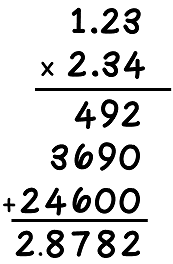Multiply and divide positive multi-digit numbers with decimals to the thousandths, including using a standard algorithm with procedural fluency.
Solve multi-step real-world problems involving any of the four operations with positive multi-digit decimals or positive fractions, including mixed numbers.
Rewrite positive rational numbers in different but equivalent forms including fractions, terminating decimals and percentages.
Students need to see the connection between fractions and decimals in order to understand how decimals work.

- Line up decimal points so that you make sure you are multiplying numbers in their correct place value spots.
- Multiply as usual, using a standard algorithm or an area model.
- The number of digits behind the decimal point in the answer should match the total number of digits behind the decimal point in both factors (4).
This pattern helps us understand decimal division.
If both numbers are multiplied by 10, their quotient stays the same.
When dividing, you are thinking of how many groups of the divisor (1.2) there are in the dividend (16.21). It’s difficult to conceptualize groups of 1.2 dividing into each digit of 16.21.
Therefore, before beginning a division problem, we multiply both numbers in the division problem by 10 until we have a whole number divisor.
Now, just divide as usual.
The decimal point in the answer goes directly above the decimal point in the dividend.
At the end of the division problem, we don’t just write the remainder separately- we include it as part of the problem!
Add a zero to the end of the dividend (162.1) to have an additional digit to bring down. Remember, adding a zero to the end of a decimal doesn’t change the value of the number, because 1/10 = 10/100.
If the problem or question does not explicitly say where to stop, stop at the hundredths’ place, even if there is still a remainder.